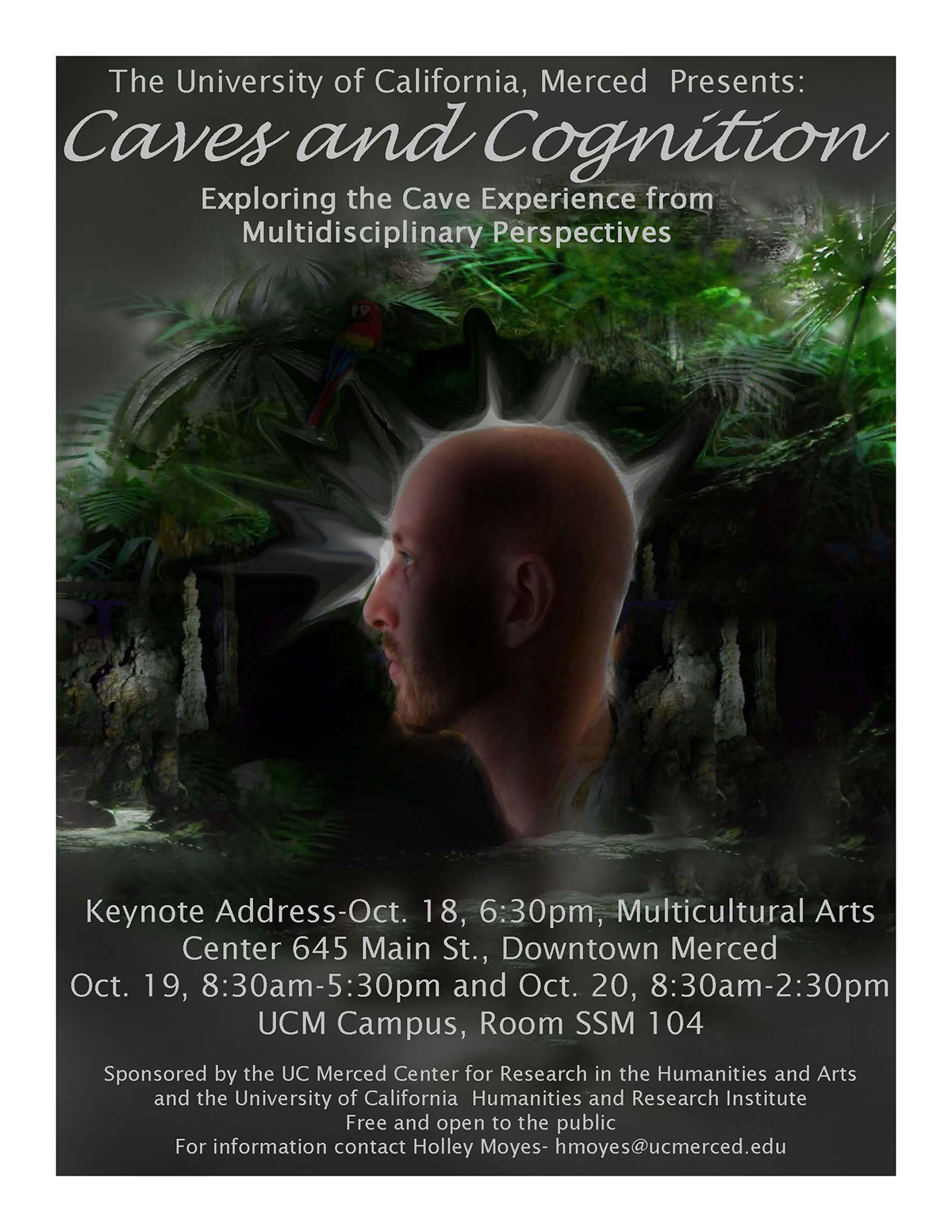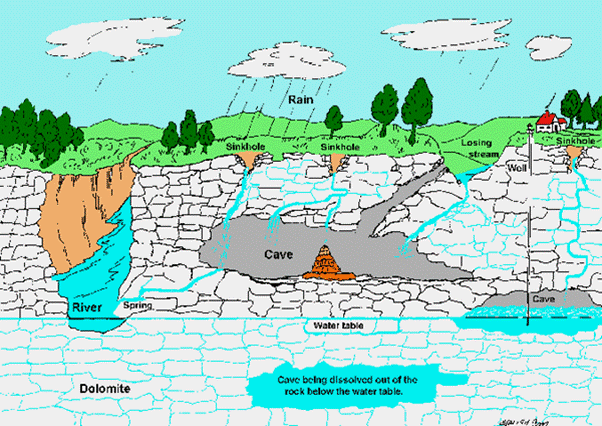A diverse and innovative symposium entitled “Caves and Cognition: Exploring the Cave Experience from Multidisciplinary Perspectives” took place October 18-20, 2012, on the campus of UC Merced, the UC system’s newest campus (Thursday’s Keynote address took place at the Multicultural Arts Center in downtown Merced). The town of Merced is in California’s Central Valley, just west of the Sierra Nevada foothills and Yosemite Valley. UC Santa Barbara Geography Professor Dan Montello co-organized the symposium along with his colleagues at UC Merced, Professors Holley Moyes (Anthropology), Teenie Matlock (Cognitive Science), and Michael Spivey (Cognitive Science). Participants included UCSB Geography Professor Helen Couclelis and Professor Emeritus Mike Goodchild.
The symposium was motivated by Professor Moyes’ (lead organizer) observations that archaeological research across cultures and time periods demonstrates that both ancient and modern people have used the dark zones of caves as ritual spaces but rarely for habitation. The dark zone in a large cave is the part with constant temperatures that sunlight does not reach. Apparently, dark zones of caves have physical properties experienced universally by humans that lead to the assignment of similar meanings to these spaces by different societies across time and place, affording their use as sacred or ritual spaces and venues for intentional semiotic communication (Moyes and Montello call these “transcendental affordances”). Anthropologists have long studied ritual and religion and have contemplated the universality of religious beliefs. Recent research trajectories focus on the structure of the mind as the fundamental causality of the occurrence of religious or spiritual beliefs. What has not been considered in these research programs is the role of human environmental perception and cognition as crucial in establishing cosmologies and other foundational beliefs. The Merced symposium focused on the role of caves in human experience and thought, including understanding the qualities of specialized cave environments that might lead to their common emotional and intellectual responses, and establishes their meaning as powerful spiritual venues.
The meeting was structured to create synergies between disciplines and stimulate new research and partnerships between the humanities, social sciences, cognitive sciences, and geosciences. Local, national, and international scholars from a dizzying array of disciplines gave a total of 18 presentations to each other and an appreciative audience of nearly a hundred others, most from UC Merced and other points nearby. Presenters came from anthropology and archeology, cognitive science, psychology, linguistics, literature, history, classics, geography and geographic information science, earth science, and architecture. Here are the presenters and the titles of their highly entertaining talks:
Thursday, October 18; Keynote Address: Paul Taçon, Chair in Rock Art Research and Director of the Place, Evolution and Rock Art Heritage Unit (PERAHU), School of Humanities, Griffith University, Queensland, Australia: “Caves, Cognition, Animals, and Artists: An Illustrated Journey Through Time, Space, Rock Art, and the Human Mind”
Friday, October 19; Session 1 “Caves in the Past”
- Yulia Ustinova, General History, Ben Gurion University of the Negev, Beer Sheva, Israel: “Ancient Greek Cave Experiences”
- Helen Couclelis, Department of Geography, University of California, Santa Barbara: “We Are All Cavemen: Plato’s Allegory of the Cave and the Perennial Search for Meaning”
- Holley Moyes, Anthropology Program, School of Social Science, Humanities and Arts, University of California, Merced: “Ritual in the Underworld: Ancient Mesoamerican Cave Use”
- Tom Hothem, Merritt Writing Program, School of Social Science, Humanities and Arts, University of California, Merced: “Caves and Character in English Literature, 1680–1820”
- Will Hunt, Free-lance writer, New York, New York: “Under Paris”
Session 2 “Caves in Media and Popular Culture”
- Chris Divelbiss, World Cultures and History Graduate Group, School of Social Science, Humanities and Arts, University of California, Merced: “Caves and Their Use in Video Games”
- Michael Barba, World Cultures and History Graduate Group, School of Social Science, Humanities and Arts, University of California, Merced: “The Light in the Darkness: The Use of Caves in the Star Trek Television and Film Series”
- Bodo Winter, Cognitive Sciences and Information Sciences Graduate Group, University of California, Merced: “Caves, Cognition and Subterranean Horror”
Session 3 “Caves and Perception, Cognition, Behavior I”
- Derek Ford, School of Geography and Earth Sciences, McMaster University, Hamilton, Ontario, Canada: “Caves and Cognition: A Physical Speleologist’s Perspective”
- Michael Goodchild, Department of Geography, University of California, Santa Barbara: “A Personal Perspective on Cave Navigation”
- Ruth Conroy Dalton, Faculty of the Built and Natural Environment, Northumbria University, Newcastle, UK: “Caves: Spatial Analysis, Navigation and Architectural Endeavour”
Saturday, October 20; Session 4 “Caves and Perception, Cognition, Behavior II”
- Maurizio Forte, World Heritage Program, School of Social Science, Humanities and Arts, University of California, Merced: “Caves, Art and Memes”
- Sarah Creem-Regehr, Psychology Department, University of Utah: “Perceiving Real and Virtual Spaces: Environment, Self, and Other”
- Daniel R. Montello, Department of Geography, University of California, Santa Barbara; Affiliate, Department of Psychological & Brain Sciences: “Why Dark Zones Are Sacred: Turning to Behavioral and Cognitive Science for Answers”
- Dennis R. Proffitt, Department of Psychology, University of Virginia: “Body-scaling of Perceived Space: How are People’s Purposes and Action Capabilities Perceptually Coupled in the Context of Caves”
- Teenie Matlock, Cognitive and Information Sciences, University of California, Merced; Daniel R. Montello, Department of Geography, University of California, Santa Barbara; and Holley Moyes, Anthropology Program, School of Social Science, Humanities and Arts, University of California, Merced: “What Do Our Students Think We Do Inside of Caves?”
- Lilly Rigoli, Cognitive and Information Sciences, University of California, Merced; Holley Moyes, Anthropology Program, School of Social Science, Humanities and Arts, University of California, Merced; Stephanie Huette, Cognitive and Information Sciences, University of California, Merced; and Michael Spivey, Cognitive and Information Sciences, University of California, Merced: “Cave-Like Environments Facilitate Magical Thinking”
The organizers gratefully acknowledge the financial assistance provided by the UC Merced Center for Research in the Humanities and Arts, the UC Humanities Research Institute, and the UC Santa Barbara Division of Math, Life, and Physical Sciences.
Editor’s note: Many thanks to Dan Montello for providing this thought-provoking material.











